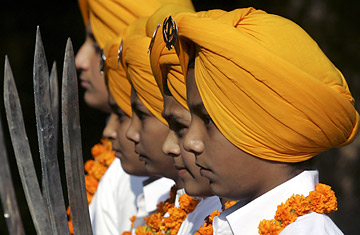
Young Indian Sikhs wear turbans.
Ever since 18-year-old Ishmeet Singh won the glitzy American Idol-inspired Voice of India contest on Star TV last month, the phone hasn't stopped ringing at his family's home in Ludhiana, the busy industrial hub of Punjab. But the kudos is about more than Singh's impressive singing prowess; he has earned it by the fact that he is a keshdhari (turban-wearing) Sikh. "It is his sabat-surat [appearance conforming to the Sikh ideal] that has brought him where he is today," says his proud father Gurpinder Singh. "He has shown other Sikh boys that they don't need a trendy hairstyle to attain stardom." At a time when more and more young Sikh men are relinquishing the turban — considered the very core of a Sikh man's cultural and religious identity — community leaders have hailed Singh's win as, literally, a godsend. Sikh blogs have been pointing out that Singh was declared a winner on Guru Nanak Jayanti, the anniversary of the birth of the founder of Sikhism. And he has been honored by the Akal Takht, the highest seat of the Sikh clergy.
Founded by Guru Nanak in northern India during the 15th century, Sikhism drew from Sufism, Islam and Hinduism, but rejected what it saw as their worst traditions, such as the Hindu caste system. It later incorporated the teachings of nine other Gurus, or teachers, which are collected in the Guru Granth Sahib, the holy book revered as the eleventh Guru. The religion claims 23 million followers today, 76 percent of whom live in the Indian state of Punjab. Although they make up only 2% of the wider Indian population, they are a close-knit and prosperous community with a strong cultural affiliation. But the battle to preserve the turban may well be the toughest facing the Sikhs since they were first rallied as a martial nation by their tenth Guru, Gobind Singh, in 1699, to fight the oppressive Mughal rulers of India. A rehatnama, or book of ordinances, dating back to this period enjoins Sikh men to wear their hair long and sport a turban. But Sikh scholars estimate that in some regions of Punjab — home to 60% of India's 14.6m Sikhs — as many as 80% of Sikhs no longer comply. And that may reflect the generational conflict in many a Sikh household, between conservative parents and children who want to break free. Dr. Rajesh Gill, a sociologist at Panjab University whose 18-year-old son sports a turban, speaks for many Sikh parents when she says, "A turban is a Sikh's pride, and I don't want my son to shear his hair once he becomes more independent."
Cutting one's hair is not new among Sikhs, but the number of turbanless, clean-shaven Sikhs has grown astronomically in the last two decades. "Thanks to the onslaught of satellite TV, there's a drive towards mainstreaming," says Gill. "Women aspire to marry men who look like Bollywood stars, and men aspire to look like the men these women want. 'The look', unfortunately, doesn't include a turban." As young people travel far for work, they feel less obligated to adhere to the demands of their culture. Jitender Singh Sandhu, a young management professional who hails from Punjab and now lives in Bangalore, cut his hair following a head injury four years back. He has since kept his hair short. "It's great not to have to tie a turban every morning and maintain long hair," he says. "It helped that I didn't have to deal with disapproving looks from my family and neighbors." Convenience is a huge factor for Sikh mothers, too — young, working mothers have no time for the elaborate, early-morning practice of tying turbans and washing boys' long hair on weekends. Moreover, community leaders feel, efforts to preach their values to young Sikhs have lagged. "In India, education has become so secular that even Sikh schools do not preach Sikhism," says Dr. Kharag Singh, editor of the journal Abstracts of Sikh Studies. "As a result, children don't realize the philosophy behind wearing a turban."
The euphoria over Ishmeet Singh's victory reflects the need of the Sikh community's elders to find turbaned role models. While Prime Minister Manmohan Singh, always seen with a spiffy turban, is an obvious example, Sikh leaders also hail pop culture icons such as the "turbanator" — cricket hero Harbhajan Singh — and popstar Daler Mehndi, whose glittering turbans are said to have inspired many a short-haired Sikh to take to the turban. Sikh organizations from Vancouver to Melbourne are renewing efforts at prachar, or preaching, to the 3 million-strong Sikh diaspora. Schools to teach young Sikhs how to tie a turban have opened in many cities, and an organization called Akal Purakh Ki Fauj has brought out "smart turban software" to help users identify the style of turban that would best suit them. Turban-tying competitions are held across Punjab on Baisakhi, the Sikh New Year, and a Mr. Singh International contest is held for turbaned Sikhs every year — as all Sikh men use the surname 'Singh,' which means lion — in which participants get points on how well they tie their turbans. Sikh clergy are to meet this week for an annual convention at which their battle plans will be refined in the escalating culture war to restore the turban to its place atop the head of the Sikh male.
